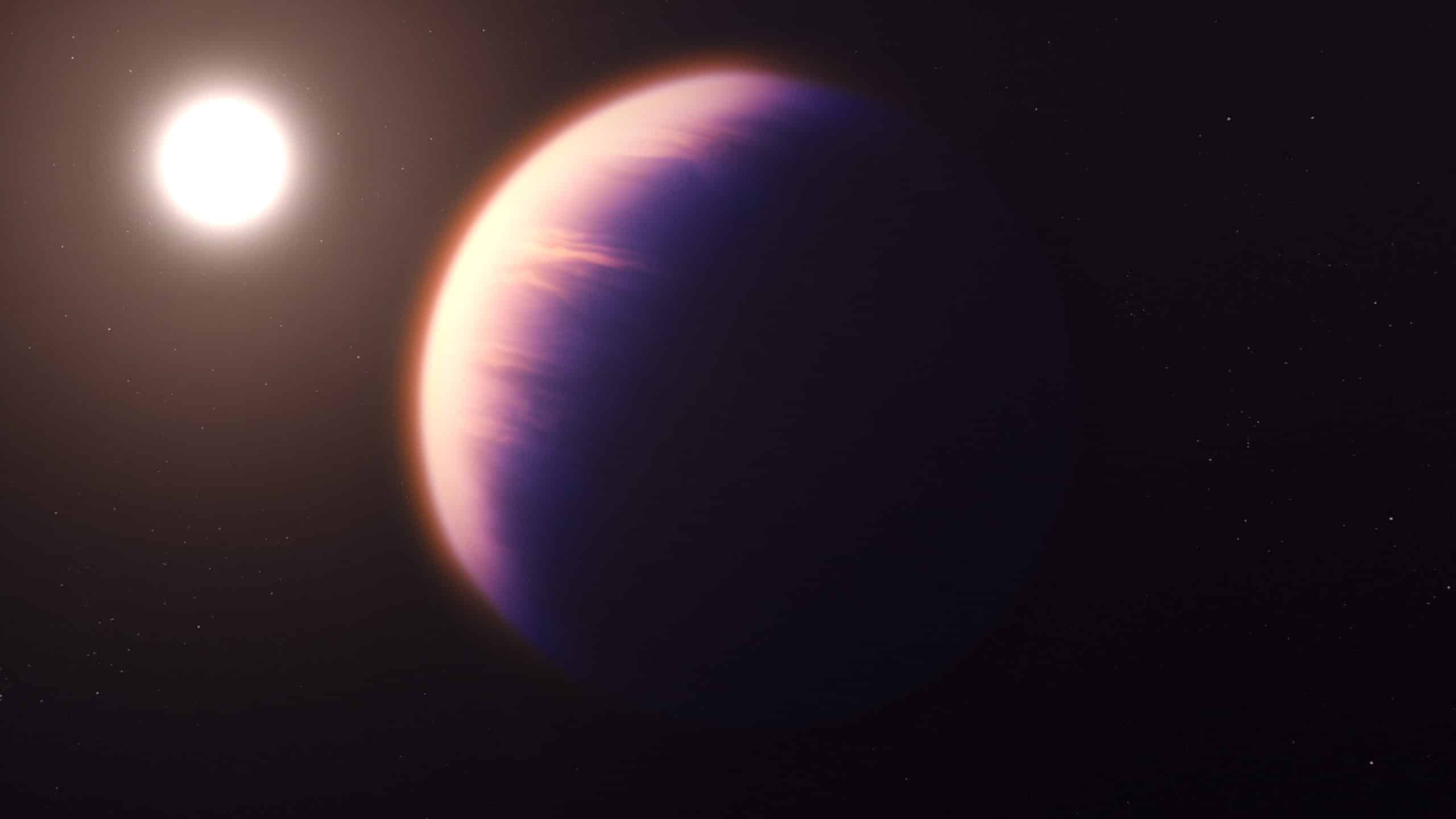First definitive detection of carbon dioxide in an exoplanet atmosphere
Friday 26th Aug 2022, 12.00am

The planet in question, called WASP-39 b, is a hot gas-giant planet orbiting a sun-like star 700 light-years away in the constellation Virgo. It has a mass roughly one-quarter that of Jupiter (about the same as Saturn), yet its diameter is 1.3 times greater than Jupiter. Its extreme puffiness (partly caused by its high temperature, about 900°C) gives it an extended atmosphere free of high-altitude clouds that makes it perfect for detailed studies of its atmosphere.
Although previous observations from Hubble, Spitzer, and other telescopes indicated the presence of water vapour, sodium, and potassium on WASP-39 b, until now, there has been no instrument sensitive enough to record a reliable, undisputed measurement of carbon dioxide on an exoplanet.
Filtered starlight
Unlike the cooler, more compact gas giants in our solar system, WASP-39 b orbits very close to its star – only about one-eighth the distance between the sun and Mercury – completing one circuit in just over four Earth-days. The planet’s discovery, reported in 2011, was made based on ground-based detections of the subtle, periodic dimming of light from its host star as WASP-39 b passes in front (transits).
During a transit, some of the starlight is eclipsed by the planet completely (causing the overall dimming) and some is transmitted through the planet’s atmosphere. Because different gases absorb different combinations of colours, researchers can analyse small differences in the brightness of the transmitted light across a spectrum of wavelengths to determine exactly what an atmosphere is made of. With its combination of inflated atmosphere and frequent transits, WASP-39 b was the ideal target for such an analysis.
An international team of over 100 scientists used Webb’s Near-Infrared Spectrograph to carry out a transmission spectrum. This compared the starlight filtered through WASP-39 b’s atmosphere as it moved in front of the star to the unfiltered starlight detected when the planet is beside the star. To capture these data, Webb recorded around 500 individual brightness measurements (about one a minute) over a period of more than eight hours on 10 July 2022, beginning about three hours before the transit and ending about two hours after the transit was complete.
Indisputable evidence
In a transmission spectrum, wavelengths absorbed by the atmosphere appear as peaks. The data from WASP-39 b showed a distinct peak between 4.1 and 4.6 microns: the first clear, detailed, indisputable evidence for carbon dioxide ever detected in a planet outside the Solar System.
Even without the strong carbon dioxide feature, this spectrum would be remarkable. No observatory has ever measured such subtle differences in brightness of so many individual colours across the 3 to 5.5-micron range in an exoplanet transmission spectrum before. Access to this part of the spectrum is crucial for measuring abundances of gases like water and methane, as well as carbon dioxide, which are thought to exist in many different types of exoplanets.
According to the researchers, detecting such a clear signal of carbon dioxide on WASP-39 b bodes well for the detection of atmospheres on smaller, terrestrial-sized planets. In addition, because carbon dioxide molecules are sensitive tracers of the story of planet formation, the measurement will enable the team to work out the proportions of solid and gaseous materials that formed this gas giant planet.
Vivien Parmentier, Associate Professor in Physics at Oxford University, who organized the modelling effort in preparation for the data analyses, said: ‘This is really a story both about science and team working. It is a first time that such a large group of exoplanet scientists have worked together, and these results showcase a brand new capability to detect carbon dioxide with amazing precision. This has far-reaching consequences, particularly because carbon dioxide is the main gas expected in smaller, rocky planets, including those which could potentially harbour life.’
‘This is really a story both about science and team working. It is the first time that such a large group of exoplanet scientists have worked together, and these results showcase a brand new capability to detect carbon dioxide with amazing precision. This has far-reaching consequences, particularly because carbon dioxide is the main gas expected in smaller, rocky planets, including those which could potentially harbour life.’
Dr Vivien Parmentier, Associate Professor in Physics at the University of Oxford
This analysis is part of the James Webb Space Telescope (JWST)’s Early Release Science program, which was designed to provide the exoplanet research community with robust Webb data as soon as possible. ‘This will allow scientists all over the world to be trained to analyse these new kind of datasets and be ready to make the most of the coming years of JWST observations’ added Associate Professor Parmentier.
In the coming decade, JWST will analyse the atmosphere of a variety of exoplanets, providing insight into the details of how planets form and the uniqueness of our own solar system.
The study Identification of carbon dioxide in an exoplanet atmosphere is published in Nature. Dr Shang-Min Tsai and Dr Xianyu Tan, in Oxford’s Physics Department also contributed to the modelling work.
You can follow the progress of the James Webb Space Telescope on the NASA website and on Twitter.

